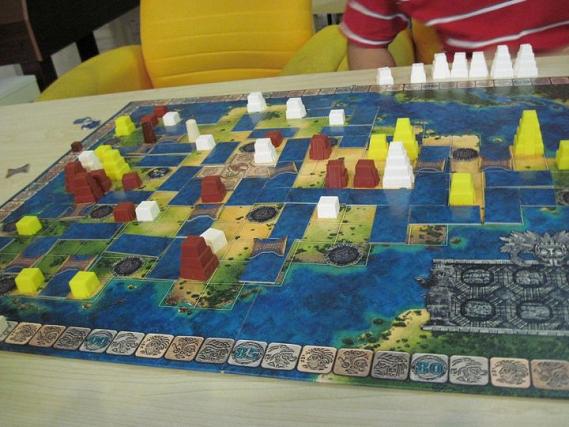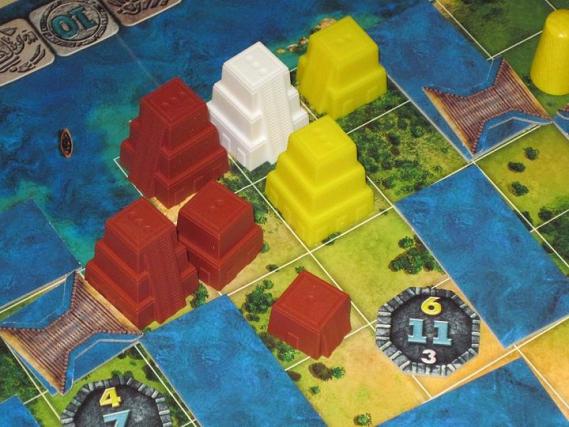8 Jul

Like Tikal, Mexica’s board is quite beautiful. The colors of the plastic pieces don’t match the board however, but do make it easy to differentiate each player’s pieces.
I suppose it’s only natural that even boardgames have trilogies or sets of oeuvres sharing a common theme by the same author, but it’s something I wouldn’t have guessed before I started this hobby. In any case, Mexica is another game in the so-called Mask trilogy that started with Tikal. It’s quite a bit simpler than the first one though, so I’ll just summarize:
- Tikal has a Mayan theme while Mexica has an Aztec one. I think I’ll go with AllLookSame on this one. That’s just a joke of course, but the exact choice of civilization and location doesn’t really matter in my opinion. I do appreciate the exoticism of both themes.
- Apparently all of the games in this trilogy use the action point allocation mechanic. But other than this and the fact that both games are about area control, the two games are really different, so it’s not as if Mexica is a rehash to capitalize on the success of the first game.
- No map hexes to place here. Instead, you play canal tiles of one or two squares each on the board to define borders for districts. The trick here is that you must create districts consisting of specific numbers of squares according to the tokens still available so expect to count squares a lot as you try to create districts using the least canal placements. You get points both for founding districts and for controlling them by virtue of having the most temples in it.
- You only get one guy to move around this time around but due to the rather unintuitive rule that moving from one bridge on a canal to another bridge uses only 1 action point, he can zip around the board surprisingly quickly. You almost always want to use this rule so physical distance on the board doesn’t keep an area safe. A player can even place a bridge on a canal without even needing to have his token there!
- Like Tikal, this game is all about tactically reacting to your opponents’ moves. Sean says he got screwed by turn order here, especially given how quickly the player token moves around the map. Plus when a scoring condition comes up, everyone plays one more round according to turn order before scores are tabulated. That stands in contrast to Tikal in which each player scores at the end of his turn. Since Sean went first, the two of us had better opportunities to react in whatever manner that would be worth the most points while there was nothing he could do about it.
- Overall, I find this to be a significantly lighter game than Tikal with a commensurately shorter playing time. It’s still a good game for what it does but I’d bet that the strategy possibility space isn’t huge and it has limited long-term replayability.

Temples from all three players competing for an 11-point district.
Written on July 8 2010 and is filed under Boardgames.
You can follow any responses to this entry through the RSS 2.0 feed.
You can leave a response, or trackback from your own site.
Leave a Reply